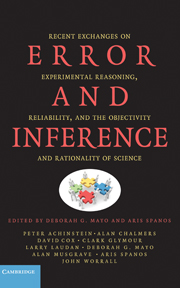 Error and Inference
Error and Inference Book contents
- Frontmatter
- Contents
- List of Contributors
- Preface
- Introduction and Background
- 1 Learning from Error, Severe Testing, and the Growth of Theoretical Knowledge
- 2 The Life of Theory in the New Experimentalism
- 3 Revisiting Critical Rationalism
- 4 Theory Confirmation and Novel Evidence
- 5 Induction and Severe Testing
- 6 Theory Testing in Economics and the Error-Statistical Perspective
- 7 New Perspectives on (Some Old) Problems of Frequentist Statistics
- 8 Causal Modeling, Explanation and Severe Testing
- 9 Error and Legal Epistemology
- Index
- References
8 - Causal Modeling, Explanation and Severe Testing
Published online by Cambridge University Press: 29 January 2010
- Frontmatter
- Contents
- List of Contributors
- Preface
- Introduction and Background
- 1 Learning from Error, Severe Testing, and the Growth of Theoretical Knowledge
- 2 The Life of Theory in the New Experimentalism
- 3 Revisiting Critical Rationalism
- 4 Theory Confirmation and Novel Evidence
- 5 Induction and Severe Testing
- 6 Theory Testing in Economics and the Error-Statistical Perspective
- 7 New Perspectives on (Some Old) Problems of Frequentist Statistics
- 8 Causal Modeling, Explanation and Severe Testing
- 9 Error and Legal Epistemology
- Index
- References
Summary
The Issues
There are at least two aspects to understanding: comprehensibility and veracity. Good explanations are supposed to aid the first and to give grounds for believing the second – to provide insight into the “hidden springs” that produce phenomena and to warrant that our estimates of such structures are correct enough. For Copernicus, Kepler, Newton, Dalton, and Einstein, the virtues of explanations were guides to discovery, to sorting among hypotheses and forming beliefs. The virtues were variously named: simplicity, harmony, unity, elegance, and determinacy. These explanatory virtues have never been well articulated, but what makes them contributions to perspicacity is sometimes apparent, while what makes them a guide to truth is obscure.
We know that under various assumptions there is a connection between testing – doing something that could reveal the falsity of various claims – and the second aspect of coming to understand. Various forms of testing can be stages in strategies that reliably converge on the truth, and some cases even provide probabilistic guarantees that the truth is not too far away. But how can explaining be any kind of reliable guide to any truth worth knowing? What structure or content of thoughts or acts distinguishes explanations, and in virtue of what, if anything, are explanations indications of truth that should prompt belief in their content, or provide a guide in inquiry?
- Type
- Chapter
- Information
- Error and InferenceRecent Exchanges on Experimental Reasoning, Reliability, and the Objectivity and Rationality of Science, pp. 331 - 375Publisher: Cambridge University PressPrint publication year: 2009


